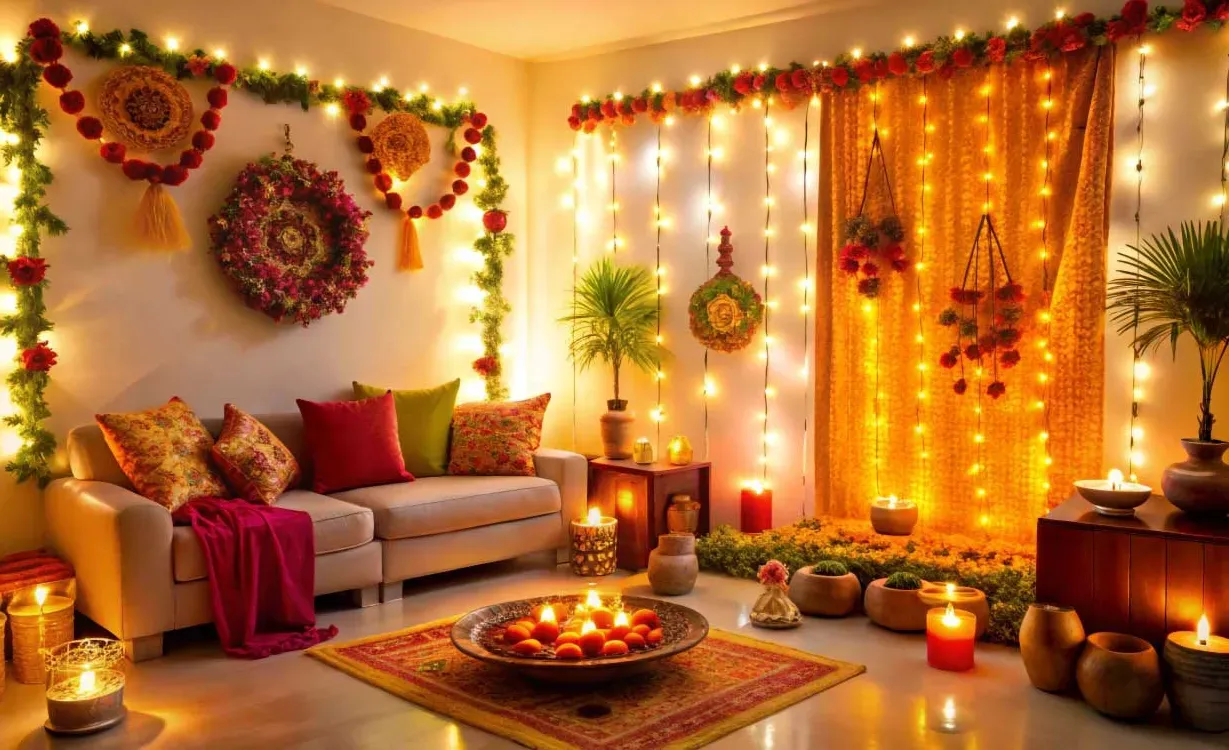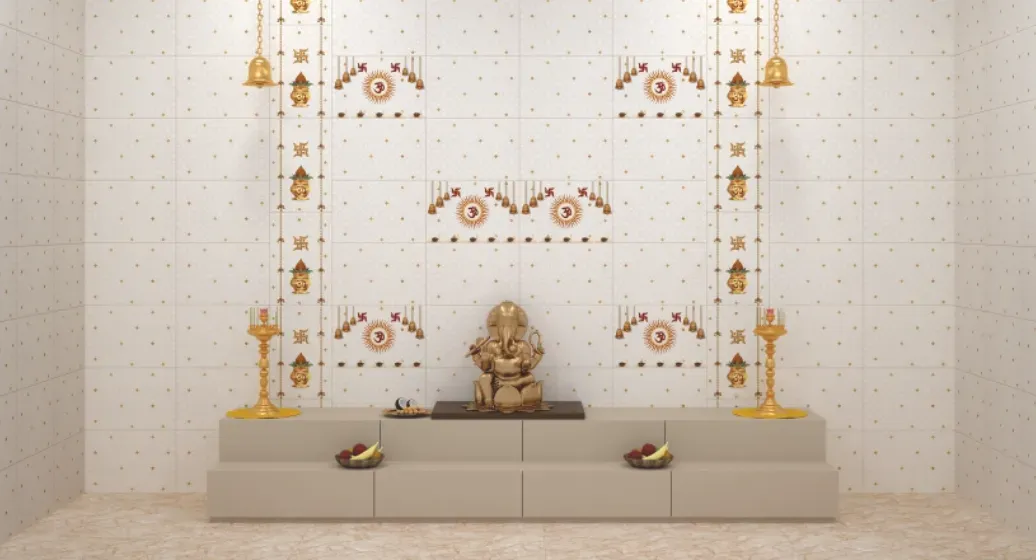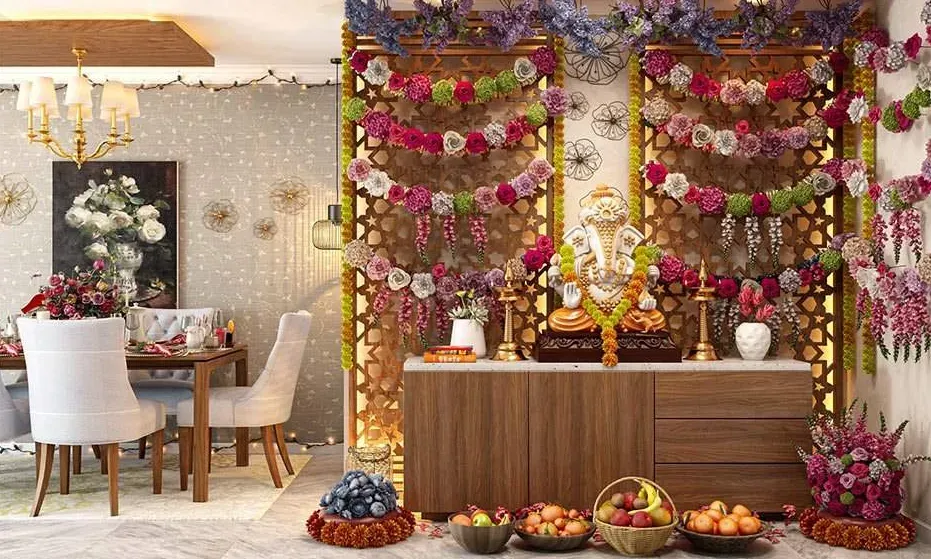Designing a Home for Indian Festivals: From Flexible Decor to Functional Pooja Rooms

By
Shrusti Naik
Posted on August 26, 2025. 10 mins

Designing a Home for Indian Festivals: From Flexible Decor to Functional Pooja Rooms
Introduction

In India, festivals are not just annual events; they are the heartbeat of cultural life. From Diwali’s diyas to Ganesh Chaturthi’s idols, from Eid’s family feasts to Christmas décor, each celebration leaves its mark on how Indian families use and experience their homes. A recent survey by Statista (2024) highlighted that Indians spend nearly 30% more on home improvement and décor during the festive season compared to the rest of the year (Source: Statista India, October 2024). This surge reflects a deep connection between living spaces and traditions. But as modern Indian homes shrink in size, especially in metros like Mumbai, Bengaluru, and Delhi, the challenge lies in balancing flexible décor, functional pooja rooms, and multipurpose layouts that can accommodate the vibrancy of festivals without compromising everyday practicality.
This blog explores how families can design homes that not only celebrate Indian festivals but also remain functional throughout the year.
Festival Homes and the Space Constraint in Urban India
Urban Indian homes are getting smaller. According to Knight Frank’s India Real Estate Report (2025), the average size of newly launched apartments in metros has reduced by 17% over the past decade. In such compact living environments, creating space for festive activities—rangolis at the entrance, seating for guests, or dedicated pooja areas, requires thoughtful design.
Traditionally, Indian homes were built around courtyards that naturally lent themselves to celebrations. Today, apartments often have just enough space for a compact living room and kitchen. Yet, demand for spiritually integrated spaces remains high. For instance, 61% of homebuyers in a 2024 ANAROCK survey considered a dedicated pooja room “essential,” despite smaller layouts. The solution lies in smart architectural choices: foldable furniture, modular storage, and flexible zones that can transition seamlessly between daily use and festive grandeur. Might as well take a look at The Resurgence of Traditional Indian Architectural Elements in Modern Homes.
The Pooja Room: Heart of an Indian Festival Home
If there is one space that embodies Indian festivals, it is the pooja room. Whether small or elaborate, this corner becomes the anchor during Diwali, Navratri, or Ganesh Chaturthi. Developers have begun responding to this demand: many new projects in Pune and Chennai now integrate a compact pooja niche into 2BHK layouts.
For homes without a separate pooja room, homeowners are adopting innovative alternatives, from carved wooden partitions in the living room to wall-mounted mandirs that blend tradition with modern aesthetics. According to a 2025 Magicbricks interior trends report, searches for “modular pooja room designs” grew by 40% year-on-year, reflecting a preference for compact yet sacred spaces.
Lighting plays a key role here. Warm tones, recessed LED strips, or even natural skylights enhance the divine atmosphere. In vastu-conscious homes, orientation of the mandir, typically east or north-east facing, continues to hold relevance. Thus, the pooja room is no longer just symbolic; it is becoming a thoughtfully integrated element of modern Indian design. With all this, here is another way to enhance your home by Choosing the Right Color Palette for Each Room
Flexible Décor: Homes that Transform with Every Festival
One of the unique challenges of Indian homes is the diversity of festivals. A living room decorated for Diwali may need to transition into a Christmas-ready space within weeks. This is where flexible décor systems become invaluable.
Modular shelving that can showcase diyas, idols, or lanterns during festivals and revert to books and art later ensures minimal clutter. Accent walls painted in neutral shades provide the perfect canvas for seasonal backdrops. Fabrics also play a versatile role—curtains, cushion covers, and rugs in festive colors like marigold yellow or deep red can be swapped in and out with ease.
In urban India, storage remains the biggest hurdle. A 2024 Godrej Interio study revealed that 78% of metro households struggle with seasonal décor storage. Solutions such as under-bed storage, vertical shelving, or even community-based rental services for festival décor are emerging as practical answers. The idea is to design homes that “celebrate in layers”, by adding or removing elements without overwhelming the space. Besides. here are some Design Choices That Can Actually Increase Your Property Value
Lighting, Ventilation, and the Festival Aesthetic
Festivals are as much about ambiance as rituals. A well-lit home is not just aesthetically pleasing but also energy-efficient. India’s LED adoption rate has crossed 60% of households as of 2024 (Source: Invest India, 2024), and festive lighting has accelerated this shift. Smart lighting systems that allow homeowners to switch from everyday task lighting to festive mood lighting at the touch of a button are gaining popularity.
Ventilation, too, becomes crucial during festivals. From diyas and incense sticks to elaborate cooking, air circulation ensures comfort and safety. Balconies and windows designed to allow cross-ventilation not only reduce energy consumption but also provide spaces for lanterns, torans, and potted plants that enhance festive décor. Also check out Fractional Ownership of Real Estate in India 2025
The Social Dimension: Guest-Friendly Homes
Festivals are also about people, relatives visiting, neighbors dropping by, and friends gathering. A home that accommodates social interactions while staying functional reflects thoughtful planning. Open layouts that merge living and dining spaces make entertaining easier. Movable partitions or sliding doors allow privacy when needed but expand the area during celebrations.
For smaller apartments, collapsible seating, floor cushions, or multipurpose benches ensure everyone has a place. Kitchens, too, need attention. Indian festive cooking can be elaborate, with sweets, fried foods, and full-course meals. Modern modular kitchens with adequate ventilation and smart storage not only ease preparation but also keep post-festival clutter under control. Besides, take a look at these Kid-Friendly Interiors That Aren’t an Eyesore
Balancing Tradition with Modernity
One of the most significant trends in Indian housing is the balance between traditional cultural needs and contemporary aesthetics. A home that accommodates a rangoli at the doorstep, a pooja corner inside, and yet feels modern with minimalist furniture and technology-enabled lighting is the emerging ideal.
Interestingly, Indian millennials and Gen Z homeowners—many of whom are now entering the housing market—are prioritizing this duality. According to Housing.com’s 2025 trend report, younger buyers seek “modern homes with cultural anchors,” reflecting a desire for authenticity without compromising convenience. This is driving demand for design hybridity: wooden jaali panels next to glass partitions, or traditional brass lamps juxtaposed with Scandinavian-style furniture.
Conclusion

Designing a home for Indian festivals is not just about aesthetics—it is about functionality, spirituality, and adaptability. As homes get smaller, creativity in design becomes essential to balance daily life with festive needs. From flexible décor systems and guest-friendly layouts to compact yet functional pooja rooms, the future of Indian homes lies in their ability to transform with the rhythm of festivals.
In essence, the true test of a modern Indian home is its ability to hold on to traditions while embracing the realities of urban living. And when designed thoughtfully, a home does not just witness festivals—it becomes a part of the celebration itself.
For those in pursuit of their dream home, investment opportunities, or a sanctuary to call their own, Jugyah provides top housing solutions with its intelligent technology.
Frequently Asked Questions
Q1. How can small apartments in India accommodate festival décor? Compact homes can use foldable furniture, modular storage, and wall-mounted décor to manage festival decorations without cluttering daily living spaces.
Q2. Is a separate pooja room necessary in modern Indian homes? While not mandatory, many buyers still prefer a pooja room or niche. Modular wall-mounted mandirs are popular alternatives in compact apartments.
Q3. What is the best lighting for Indian festivals at home? Warm LED lighting and smart systems that adjust brightness or color are ideal for creating festive ambiance while staying energy-efficient.
Q4. How can homes be designed for both guests and festivals? Open layouts, collapsible seating, and multipurpose furniture allow homes to adapt for gatherings without permanently occupying space.
Q5. Do developers in India provide pooja rooms in new projects? Yes, many developers now integrate small pooja niches in 2BHK or 3BHK layouts, especially in culturally rooted cities like Pune, Chennai, and Hyderabad.